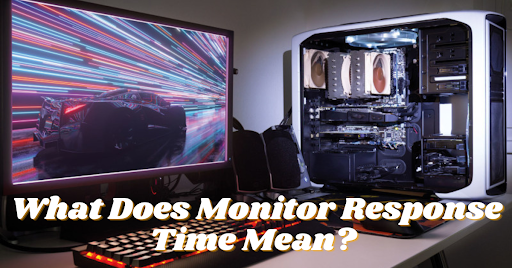What Does Monitor Response Time Mean?

What Does Monitor Response Time Mean? The answer is that, it is one of the trickier characteristics to check for in a computer monitor is response time. This is due to the fact that it is one of the least useful features, offering nothing to the average user. Response time has to do with how quickly the colors on your display transition from one another.
What Is the Monitor Response Time?
Monitor response time is the time required to change colors. The length of time that it takes for a picture to change from black to white and black again has been frequently expressed in milliseconds (ms). Gray-to-gray (GtG) and occasionally even black-to-white are other options, though.

Black to white and vice versa typically takes 10 milliseconds. However, LCD panels have reaction times that are less than 10ms, so that’s another point of comparison. However, the better the generation of images and motion, the faster the response time must be. The responsiveness of different panel types varies, with TN panels often being far more sensitive than IPS panels. However, all of that is altering, particularly with nano-IPS.
What Does Monitor Response Time Mean? And why it matters?
You’ll encounter a deluge of technical specifications while looking for a new display. While factors like screen resolution are fairly clear, response time is another crucial element.
Response time: The duration it takes for the colors on your panel to change. This is often measured in milliseconds, or the time it takes to transition between black to white to black again. A common LCD reaction time is less than 10 milliseconds (10 ms), and some are much faster.
There is disagreement about the precise methodology for calculating this statistic; some manufacturers describe it in terms of the LCD screen switching from black to white, black to white to black, and very often, “gray to gray.” This entails traversing the same whole spectrum but beginning and finishing on subtler, trickier grayscale values. Lower average times are always preferable since they reduce picture problems like blurring or “ghosting.”
Response time and monitor refresh rate are two different concepts. Although they have similar names, the refresh rate measures how many times a screen shows a fresh image per second and is measured in Hertz. Although some go higher and greater is better some displays employ a refresh rate of 60 Hertz or higher. In contrast, a shorter response time is preferable.
What distinguishes response time from frame rates or frame rate?
You may have also come across the words refresh rate and frame rate. It is significant to highlight that although these are quite distinct, they might be mistaken.
Refresh rate | Frame rate |
| The terms refresh frequency and frame speed may also have crossed your path. It is important to emphasize that even though these are clearly different, they could still be confused. Update frequency frame rate It refers to how frequently your monitor shows a new image per second. This is measured in hertz (Hz). The greater the hertz, the smoother the image. The refresh rate is directly influenced by the screen or other display hardware. Make sure your refresh frequency and frame speed are enough, though, for the optimum experience. | It is how swiftly those images are displayed. This was measured with a frame rate of (fps). Every displayed image is a frame, and it’s the quick changes between them that give you the images you see on the monitor. In other words, if you see 30 frames per second, your display is shifting between 30 different static images. Your monitor is not a factor in determining frame rate; rather, it depends on the program, graphics card, and CPU working together (CPU). |
About latency
Simply said, latency is the amount of time between when a request is issued and when it receives a response. You will obtain a summary of the service time and round-trip latency after it has been processed and received. Better latency, however, can speed up your reaction time by a full millisecond!
Procedures to test the response time
The science and significance of response time are, indeed, quite complex. Even some technicians could struggle with it. But there are a number of great resources accessible if you’re interested in learning more about response time.

Useful but difficult methods known as response time tests can be used to gauge the monitor’s response time. These are especially useful for screens having gray-to-gray reaction times since they are better suited for video and motion. Through these tests, you will get knowledge of moving picture responsiveness (MPRT). In contrast, turnaround time for moving images quantifies the period of time that such a pixel—whose colors have already changed—is visible.
Why Response Time Matters?
After knowing What Does Monitor Response Time Mean? Another question arises.
If you only sometimes browse, buy, or scroll on the internet, the response time isn’t really a big deal. If you often use your PC for tasks like watching movies or videos, response time could not even be a major worry for you.
If you’re gaming or a producer, response speed may be even more crucial. It could truly matter to you when your response time is one per five milliseconds or fewer. Additionally, it makes motion more lucid and reduces “ghosting.”
However, if you regularly have eye strain and headaches, keep in mind that longer reaction times may signal that the panel does not have advanced picture manipulation, such as improved luminance as well as blue light shielding that protects your eyes. A display with high responsiveness might not be necessary.
Should You Think About Faster Response Times?
Most certainly, if you’re a player or videographer.
For instance, having a quicker response time is essential to ensuring your dominance in professional e-sports. Response time, however, might not be the most important feature to take into account if you use a computer on a regular basis for stuff like commercial enterprises or just leisure browsing.

The View-Sonic Elite XG2405 has a short reaction time of 1 millisecond (GtG) as well as a refresh frequency of 144Hz, making it a fantastic monitor for purposes demanding response time. It is also perfect for videography. Or visit this page to learn more about the high-performance gaming monitors from View-Sonic Elite.
Conclusion
Finally we can conclude that your answer to What Does Monitor Response Time Mean? Has been provided, hope it got you what you intended.